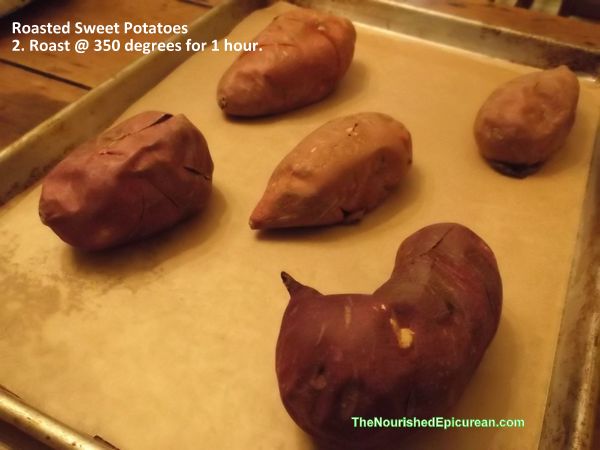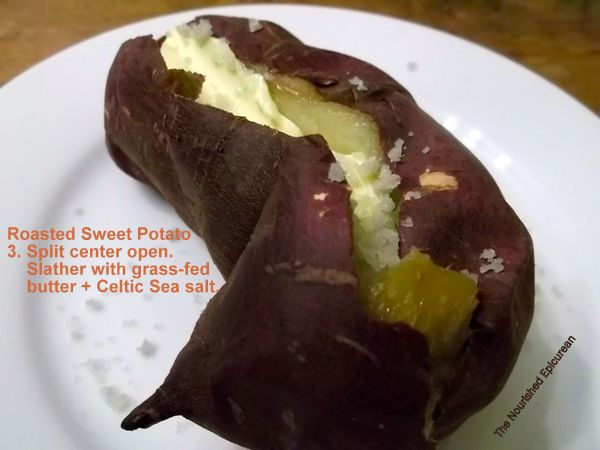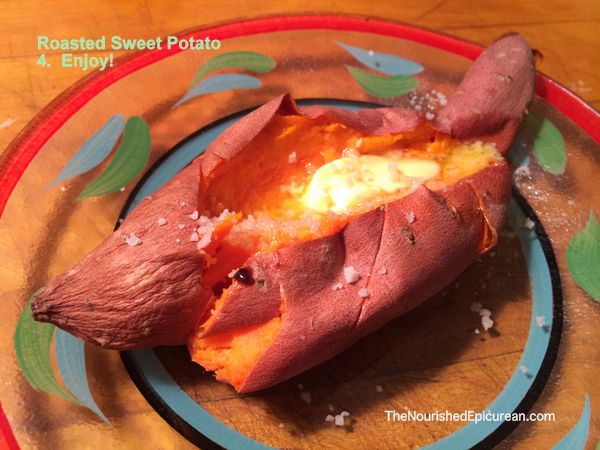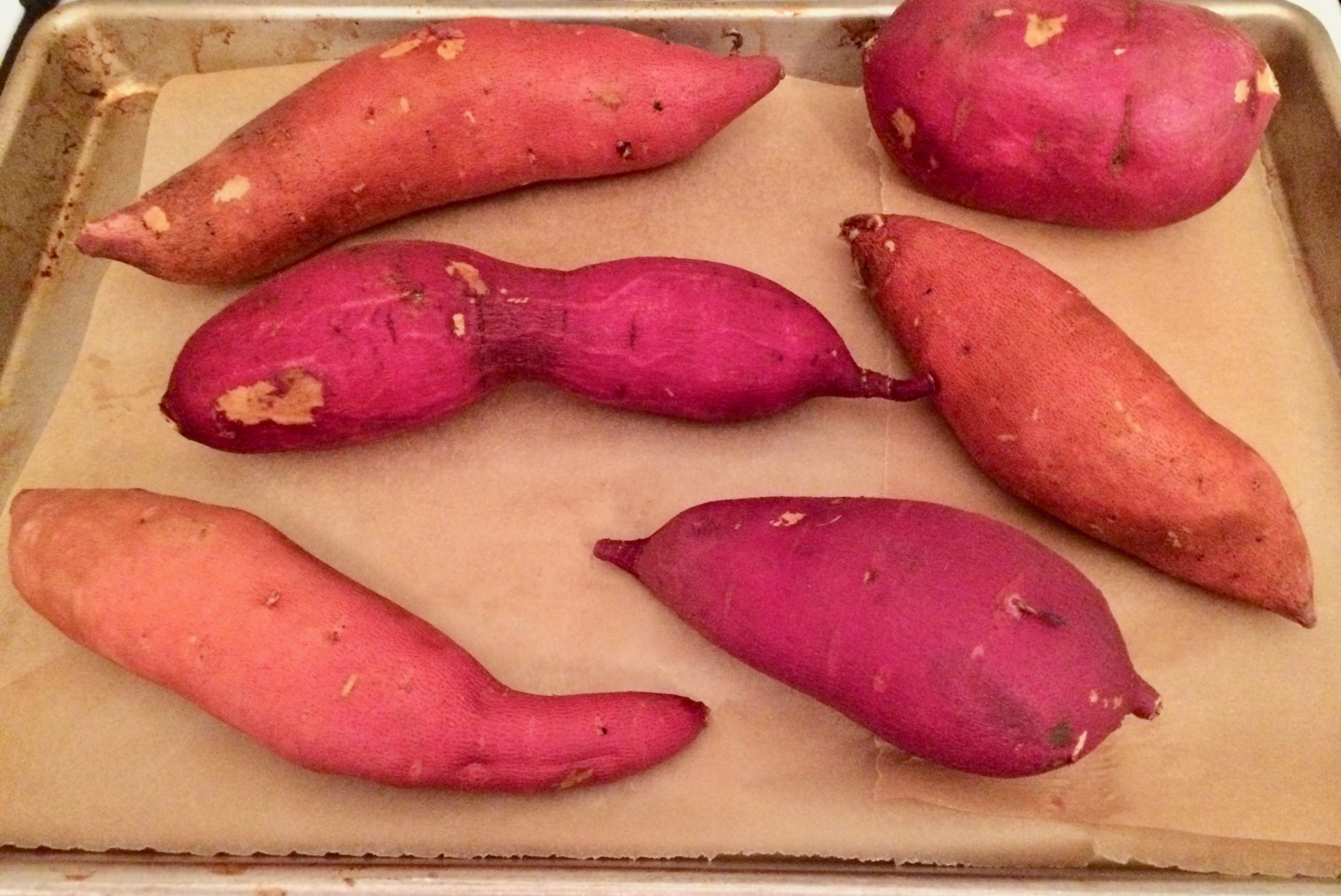Where can you find sweet comfort that’s actually good for you, versatile, deliciously satisfying—and portable to boot?
In a sweet potato…that’s where!
I grew up in a family of sweet potato lovers (my parents, especially, adored eating them plain). Not me. I studiously avoided those orange-fleshed tubers at Thanksgiving (or any other time of year). I’m not sure why I didn’t cotton to sweet potatoes, though I vaguely recall finding them unappealing because of their thick skin, plain taste and fibrous texture. I probably didn’t care for the supermarket variety—Beauregard and Jewel are the two most common commercial varieties. Or, maybe it’s because—as I later learned—the skin of conventionally grown sweet potatoes is often treated, post-harvest (with dye or wax).
Now, sweet potatoes are a staple in my kitchen. (They’re also the perfect post-workout snack: one medium (apx. 7 ounces) sweet potato has 950 mg of potassium.)

Several years ago, I rediscovered sweet potatoes at a local farmers’ market. I bought them from a farm vendor practicing “beyond organic” farming (as they call it), using no spray on their crops. Their beautiful, intensely flavorful produce and herbs draw a near cultish customer following.
Among several varieties of sweet potatoes, I became especially enamored with the purple-skinned Japanese sweet potato and its dense creamy white flesh, hinting at a chestnut-like sweetness.
Since then, I have found that organic sweet potatoes—whether from the farmers’ market or the health food store—to be superior in terms of quality, texture and taste (having a more pronounced sweetness) compared to conventionally grown ones.
There are roughly 400 varieties of sweet potatoes. All of them, however, fall into one of two types: one, where the flesh is firm and dry, almost mealy, when cooked. Or, the second, where the flesh becomes soft and moist when cooked.

Sweet potatoes are a nutritional powerhouse. They are an exceptional source of antioxidants, including beta-carotene found in orange-fleshed sweet potatoes, and anthocyanins found in purple flesh varieties. An excellent source of Vitamin A (in the form of beta-carotene), sweet potatoes are a very good source of vitamin C, B5 (pantothenic acid) and vitamin B6 and minerals, including manganese and copper. They are also good source of vitamins B1, B2 and B3 (niacin) as well as the minerals, potassium and phosphorus.
I’m not eating refined sugar, wheat or grains these days, but, occasionally (especially in the week preceding my period), I have starch-carb cravings. When I do, I roast a few sweet potatoes.
An ideal snack, sweet potatoes contain both soluble fi
Soluble fiber (45%) and insoluble fiber (55%). Soluble fiber delays stomach emptying, which makes you feel fuller and helps stabilize blood sugar; it can also help with lowering LDL cholesterol. Insoluble fiber, present in root vegetable skins, adds bulk and has a laxative effect, preventing constipation.
In my own experience (and I’m a big eater!), binging on sweet potatoes is virtually impossible because they are SO filling and satisfying. Sweet potatoes are loaded with vitamin A, a fat-soluble vitamin, which means that eating sweet potatoes with a healthy fat—grass-fed butter, coconut oil or extra-virgin olive oil—will help you maximize your absorption of vitamin A.

Roasting sweet potatoes requires zero “cooking skills”. You can roast in advance for an easy grab-and-go snack. But don’t try “roasting” sweet potatoes in a microwave! (A friend who did was sorely disappointed by the end result!!)
Roasted Sweet Potatoes
4-6 organic sweet potatoes (keep the skins on)
Grass-fed butter, coconut oil, or olive oil
Celtic sea salt
Preheat oven to 350 degrees.
Line a heavyweight (I use stainless steel) cookie sheet with unbleached parchment paper.
Rinse sweet potatoes thoroughly (remove all grit from skin).
Dry sweet potatoes with a paper towel and arrange on parchment-lined baking sheet.
Cut a few diagonal slits in the sweet potato (to allow steam to escape).
Place sweet potatoes on center rack in oven. Roast 30 minutes. Turn cookie sheet around. Roast another 30 minutes, or until knife inserted in sweet potato slides out easily.
If not eating immediately, let cool. Wrap in parchment paper and aluminum foil and refrigerate. Rewarm before eating.


